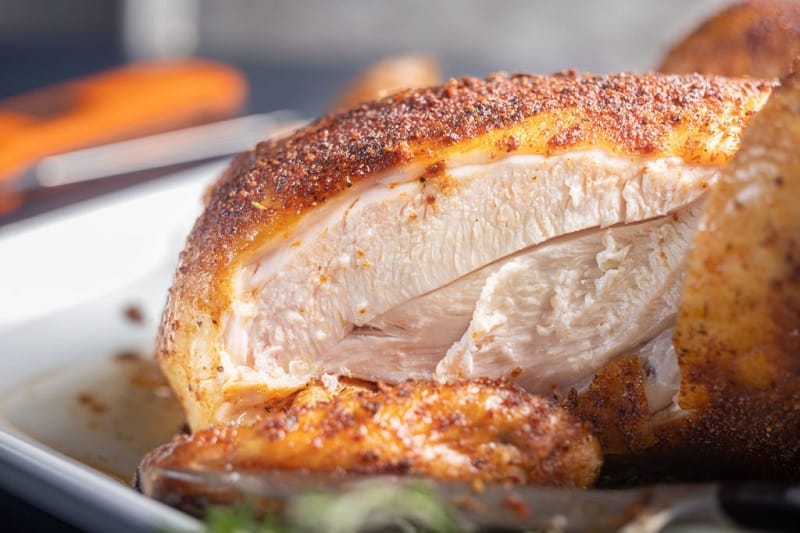Smoking chicken is an art that has been perfected over generations, a culinary technique that not only enhances flavor but also ensures the meat’s juiciness and tenderness. Among enthusiasts and culinary experts, the magic number often debated is the internal temperature at which the dish is considered perfectly done.
In this exploration, we delve deep into the heart of smoking chicken, dispelling myths, presenting facts, and guiding you toward achieving that lip-smacking, perfectly smoked chicken every time.
Understanding the Science
At its core, smoking is a slow-cooking method that uses low temperatures over an extended period. This process not only imparts a unique flavor to the chicken but also ensures that it’s cooked evenly without the moisture being zapped out of the meat.
The science behind this method revolves around the protein structures in the chicken, which begin to break down and become tender at certain temperatures – a process essential to achieving the perfect texture and taste.
The Significance of 160°F
The United States Department of Agriculture (USDA) has long recommended that poultry be cooked to an internal temperature of 165°F to safely eliminate pathogens like Salmonella and Campylobacter. However, when it comes to smoking, many culinary experts argue that bringing the internal temperature to 160°F is sufficient. At 160°F, the texture is at its peak tenderness and juiciness, which many believe strikes the perfect balance between safety and culinary enjoyment.
One of the reasons behind this slight deviation from USDA guidelines is the concept of “carryover cooking”. Carryover cooking refers to the phenomenon where the internal temperature of meat continues to rise even after it’s removed from the heat source. Thus, a chicken breast or thigh taken off the smoker at 160°F can reach the USDA’s recommended 165°F through rest.
The Role of Brining in Achieving Perfection

Source: blog.thermoworks.com
An often overlooked yet crucial step in smoking chicken is bringing. Brining – soaking it in a solution of water, salt, and sometimes sugar and spices – helps in moisture retention during the smoking process.
A well-brined chicken, when smoked to the right internal temperature, can enhance the moisture and flavor, making the discussion about the perfect internal temperature even more pertinent.
Techniques for Accurately Measuring Temperature
To achieve the perfect smoked chicken, mastering the art of temperature measurement is key. The use of a reliable, instant-read thermometer cannot be overstated.
Inserting the thermometer into the thickest part of the chicken, avoiding bones, provides the most accurate reading. It’s this precision that ensures the chicken reaches that pivotal 160°F, setting the stage for a succulent result.
Smoked Chicken: Beyond the Temperature
While the focus on reaching 160°F is pivotal, achieving the perfect dish transcends temperature. Factors such as the type of wood used for smoking, the consistency of the smoke, and the overall time spent by the smoker play significant roles in flavor development.
Experimentation with different woods like hickory, apple, or mesquite can introduce a range of subtle to bold flavors, each contributing uniquely to the smoking process.
In Conclusion
Achieving the perfect smoked chicken is a confluence of science, technique, and passion. While the discussion of internal temperatures will always be at the forefront, understanding that 160°F can indeed result in a perfectly safe and deliciously tender smoked chicken is crucial. Combined with proper brining, accurate temperature measurement, and a flair for flavor experimentation, this guideline opens the door to exploring the full potential.
In the realm of smoked meats, armed with knowledge and culinary curiosity, the journey from good to great is not just about following temperatures but understanding the subtleties that make your dish a true culinary masterpiece.

Hey there, barbecue lovers! I’m Mike Jones, the proud owner of Austin’s Live Fire Barbecue, where we specialize in serving up mouthwatering Central Texas-style barbecue. At our restaurant, we’re all about slow-cooking our meats over open flames, infusing them with that signature smoky flavor that you can’t resist.
When you visit us, you can expect to feast on tender brisket, juicy ribs, and flavorful sausages, all cooked to perfection using traditional methods passed down through generations. We take pride in sourcing the finest cuts of meat and using our secret blend of spices to create a truly unforgettable dining experience.
